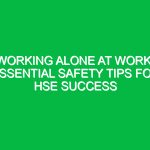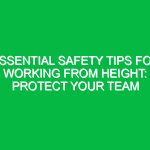Welcome and Purpose
Good morning, team! Today, we’re gathering for a Toolbox Talk focused on a crucial aspect of our work: Excavation Safety. As we prepare to start our tasks, it’s essential to recognize the importance of Safety in excavation projects. Excavation work can be hazardous, and our goal is to ensure that everyone understands the risks and knows how to mitigate them. By the end of this talk, you’ll have a clearer understanding of excavation Safety protocols and practices that we can implement to keep our workplace safe.
Understanding Excavation Safety
Excavation Safety involves the strategies and practices designed to protect workers from the Hazards associated with digging or excavating ground. These Hazards can include cave-ins, falling loads, hazardous atmospheres, and equipment-related accidents. Understanding these risks is the first step in creating a safe work Environment.
Why is Excavation Safety Important?
Each year, numerous accidents occur related to excavation work. According to OSHA, trench collapses can be fatal, with approximately 100 workers dying annually from these incidents. By adhering to excavation safety practices, we can significantly reduce these risks and protect our team members. Remember, safety is not just a personal concern; it’s a collective responsibility. Each of us plays a vital role in maintaining a safe work environment.
Key Hazards in Excavation Work
Let’s dive deeper into the specific hazards we may encounter during excavation work:
- Cave-Ins: This is one of the most dangerous hazards. Soil can shift unexpectedly, leading to a collapse that can bury workers.
- Falling Loads: Tools, materials, or equipment can fall into the excavation site, posing risks to workers inside or nearby.
- Hazardous Atmospheres: Excavations may expose workers to toxic gases or low oxygen levels, especially in confined spaces.
- Equipment Accidents: Heavy machinery, such as excavators and backhoes, can cause serious injuries if not operated safely.
Best Practices for Excavation Safety
Now that we understand the hazards, let’s discuss some Best Practices to ensure our excavation work is safe:
1. Conduct a Site Assessment
Before any excavation begins, it’s vital to conduct a thorough site assessment. This includes:
- Identifying underground utilities, such as gas, water, and electric lines.
- Evaluating soil conditions to determine stability.
- Assessing the surrounding environment for potential hazards.
2. Implement Protective Systems
Utilize protective systems such as:
- Trench Boxes: These are used to prevent cave-ins by providing a safe space for workers.
- Shoring: This involves creating a support system for the walls of the excavation to prevent collapse.
- Sloping: This technique involves cutting back the sides of the excavation to a safe angle.
3. Proper Training and Communication
All workers involved in excavation must be properly trained. Regular Toolbox Talks can help reinforce safety practices. Encourage open communication among team members regarding safety concerns and Procedures.
4. Use Personal Protective Equipment (PPE)
Ensure that all workers wear appropriate PPE, including:
- Hard hats to protect against falling objects.
- High-visibility vests for better visibility on site.
- Steel-toed boots to protect feet from heavy objects.
5. Maintain Clear Access and Egress
Always ensure that there are clear pathways for workers to enter and exit the excavation site. These should be at least 18 inches wide and free from obstructions. Emergency exits should be clearly marked and easily accessible.
Real-Life Scenarios and Lessons Learned
Let’s discuss a hypothetical scenario that illustrates the importance of excavation safety:
Imagine a crew is working on a trench that is five feet deep. They didn’t assess the soil conditions properly, and without shoring, the walls of the trench began to collapse. One worker was caught and suffered serious injuries. This incident could have been avoided with proper planning, training, and protective measures.
In another case, a team was working near a water main. They failed to mark the utility lines properly, leading to a rupture that caused flooding and halted the project for weeks. This scenario emphasizes the importance of conducting thorough site assessments and ensuring all underground utilities are identified and respected.
Regulations and Standards
When it comes to excavation safety, compliance with Regulations is critical. The Occupational Safety and Health Administration (osha) sets forth regulations for excavation work, which include:
- OSHA Standard 1926.650 – Subpart P: Excavations, which outlines the requirements for excavation safety.
- Regular inspections of excavation sites.
- Proper training for workers involved in excavation activities.
Failure to comply with these regulations can result in severe penalties and, more importantly, jeopardize the safety of our team. Always prioritize compliance to protect yourself and your coworkers.
Engagement and Open Dialogue
At this point, I want to open the floor for discussion. Here are a few questions to consider:
- What are some potential hazards you’ve encountered in previous excavation projects?
- How can we improve our current excavation safety practices?
- Are there any specific training needs you think we should address?
Feel free to share your thoughts and experiences. Remember, your insights are valuable in creating a safer work environment for all of us.
Conclusion and Commitment to Safety
As we wrap up this Toolbox Talk, let’s summarize the key points we covered:
- Understanding the key hazards associated with excavation work.
- Implementing Best Practices to mitigate risks.
- Recognizing the importance of training and communication.
- Complying with regulations to ensure safety.
It is each of our responsibilities to prioritize Excavation Safety in our daily operations. By following the guidelines we discussed today, we can work together to prevent accidents and create a safe working environment. Thank you all for your attention and commitment to safety. Let’s have a productive and safe day ahead!


